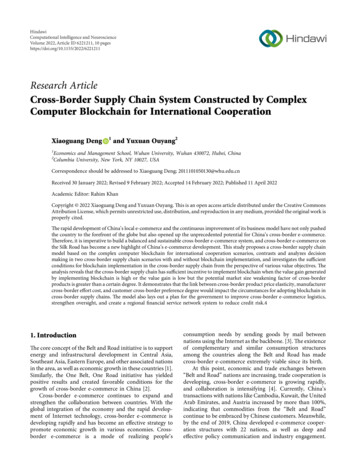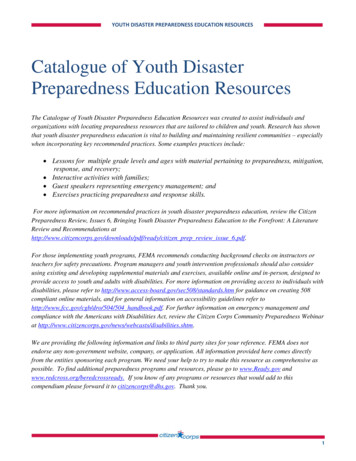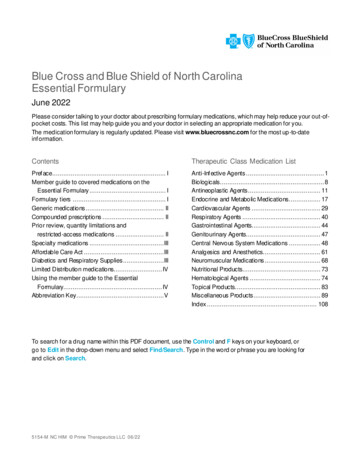
Transcription
HindawiComputational Intelligence and NeuroscienceVolume 2022, Article ID 6221211, 10 pageshttps://doi.org/10.1155/2022/6221211Research ArticleCross-Border Supply Chain System Constructed by ComplexComputer Blockchain for International CooperationXiaoguang Deng121and Yuxuan Ouyang2Economics and Management School, Wuhan University, Wuhan 430072, Hubei, ChinaColumbia University, New York, NY 10027, USACorrespondence should be addressed to Xiaoguang Deng; 2011101050130@whu.edu.cnReceived 30 January 2022; Revised 9 February 2022; Accepted 14 February 2022; Published 11 April 2022Academic Editor: Rahim KhanCopyright 2022 Xiaoguang Deng and Yuxuan Ouyang. This is an open access article distributed under the Creative CommonsAttribution License, which permits unrestricted use, distribution, and reproduction in any medium, provided the original work isproperly cited.The rapid development of China’s local e-commerce and the continuous improvement of its business model have not only pushedthe country to the forefront of the globe but also opened up the unprecedented potential for China’s cross-border e-commerce.Therefore, it is imperative to build a balanced and sustainable cross-border e-commerce system, and cross-border e-commerce onthe Silk Road has become a new highlight of China’s e-commerce development. This study proposes a cross-border supply chainmodel based on the complex computer blockchain for international cooperation scenarios, contrasts and analyzes decisionmaking in two cross-border supply chain scenarios with and without blockchain implementation, and investigates the sufficientconditions for blockchain implementation in the cross-border supply chain from the perspective of various value objectives. Theanalysis reveals that the cross-border supply chain has sufficient incentive to implement blockchain when the value gain generatedby implementing blockchain is high or the value gain is low but the potential market size weakening factor of cross-borderproducts is greater than a certain degree. It demonstrates that the link between cross-border product price elasticity, manufacturercross-border effort cost, and customer cross-border preference degree would impact the circumstances for adopting blockchain incross-border supply chains. The model also lays out a plan for the government to improve cross-border e-commerce logistics,strengthen oversight, and create a regional financial service network system to reduce credit risk.41. IntroductionThe core concept of the Belt and Road initiative is to supportenergy and infrastructural development in Central Asia,Southeast Asia, Eastern Europe, and other associated nationsin the area, as well as economic growth in these countries [1].Similarly, the One Belt, One Road initiative has yieldedpositive results and created favorable conditions for thegrowth of cross-border e-commerce in China [2].Cross-border e-commerce continues to expand andstrengthen the collaboration between countries. With theglobal integration of the economy and the rapid development of Internet technology, cross-border e-commerce isdeveloping rapidly and has become an effective strategy topromote economic growth in various economies. Crossborder e-commerce is a mode of realizing people’sconsumption needs by sending goods by mail betweennations using the Internet as the backbone. [3]. The existenceof complementary and similar consumption structuresamong the countries along the Belt and Road has madecross-border e-commerce extremely viable since its birth.At this point, economic and trade exchanges between“Belt and Road” nations are increasing, trade cooperation isdeveloping, cross-border e-commerce is growing rapidly,and collaboration is intensifying [4]. Currently, China’stransactions with nations like Cambodia, Kuwait, the UnitedArab Emirates, and Austria increased by more than 100%,indicating that commodities from the “Belt and Road”continue to be embraced by Chinese customers. Meanwhile,by the end of 2019, China developed e-commerce cooperation structures with 22 nations, as well as deep andeffective policy communication and industry engagement.
2[5]. Cross-border e-commerce cooperation among countriesalong the Silk Road has gradually increased in areas such aselectricity, railroads, and finance, and cooperation amongcountries along the Silk Road has further deepened [6].The development of cross-border e-commerce is inseparable from the support of the supply chain, which is anetwork chain structure jointly constructed by the coreenterprises and consumers involved in the process ofcommodity circulation. As shown in Figure 1, the crossborder supply chain is a typical complex distributed scenario, which not only involves many types of role entitiessuch as suppliers, customers, distributors, and consumers,but also contains a variety of data such as goods flow, capitalflow, and information flow [7]. It can be observed thatintegrating the complicated data flow, sharing data securelyacross different players that do not completely trust eachother, and promoting secure collaboration among multiplestakeholders in the supply chain are the key to improvingoverall supply chain efficiency. Location technology isnaturally suitable for solving the above-mentioned supplychain industry problems [8].The block supply chain is a supply chain system basedon blockchain which helps in building a trusted supplychain alliance based on the blockchain network to sharedata securely. The blockchain data structure is used toachieve accurate traceability of supply chain data, ensuringthat each link of data can be confirmed through the qualityof digital signature and time-stamped proof of existence. Itcan effectively solve disputes between participating entitiesin the supply chain, realizing easy evidence and establishingrights and responsibilities [9]. Although blockchain technology has effectively solved the problem of lack of trustamong supply chain entities, it has also introduced newproblems. On the one hand, the redundant storage natureof blockchain technology brings great disk space consumption, causing considerable storage pressure on theserver. On the other hand, the current blockchain applications present multidimensional heterogeneity, whichdiffers in the choice of the underlying platform andbusiness logic design [10, 11].This study proposes a model of cross-border supplychain system based on complex computer blockchain forinternational economic cooperation scenarios, comparesand analyzes the decision making in two scenarios ofunimplemented and implemented blockchain in the crossborder supply chain, and explores the sufficient conditionsfor implementing blockchain in the cross-border supplychain from the perspective of different value objectives.Furthermore, the present analysis reveals that the relationship between the price elasticity coefficient of crossborder products, the cross-border effort cost coefficient ofmanufacturers, and the cross-border preference degree ofconsumers will influence the conditions for implementingblockchain in cross-border supply chain.The rest of the manuscript is structured as follows:Section 2 is about related works. In Section 3, the proposedmodel is described, and different assumptions are illustrated.Section 4 illustrates the cross-border supply chain. Section 5provides an analysis of blockchain implementationComputational Intelligence and NeuroscienceCargo logisticsCapital flowInformation flowCustoms systemE-commercesystemlogistics systemSupplierCustomsDistributorconsumerFigure 1: Cross-border e-commerce supply chain.conditions under different value objectives. Section 6 explains the different results, and Section 7 concludes themanuscript.2. Related WorkCross-border e-commerce is a type of business activity inwhich the main body of the transaction is transactionsbetween different customers, and the two sides reach anagreement through the e-commerce platform to completethe transaction by carrying out payment and settlement andtransporting goods across the border. The circulation ofproducts has slowed in recent years as the global economy’sand trade’s growth rates have slowed. To address this issue,the flow of goods must be increased continuously, and theeconomy’s and trade’s growth rates must be boosted. Moreand more businesses are reducing the gap between themselves and international consumers to increase commoditiessales. Cross-border e-commerce should be shipped out inthis economic climate; now, cross-border e-commerce is stillincreasing swiftly, progressively altering the global economictrend.In recent years, along with the rapid development ofcross-border e-commerce and blockchain technology,more and more experts, scholars, and business people arecommitted to exploring the innovation and applicationimplementation of the block supply chain. Chen [12] proposed a blockchain-based dynamic multicenter collaborativeauthentication model for supply chains, introduced ablockchain transaction structure applicable to fusing business-to-business (B2B) and business-to-customer (B2C)supply chain electronic transactions, and analyzed theproblems faced by the diffusion of blockchain technology inB2B B2C supply chains. The blockchain transactionstructure for electronic transactions in supply chains integrating B2C models was introduced, and the problems facedin promoting blockchain technology in B2B B2C supplychains were analyzed. Iyama et al. [13] constructed ablockchain e-commerce product traceability and anticounterfeiting model, using blockchain technology to traceproduct information and prevent tampering. The authors in[14] proposed a scheme combining blockchain, Bitcoinprotocol deterministic hierarchical wallet, and multiplesignature technologies to meet the needs of product coding,authority management, transfer of physical rights, product
Computational Intelligence and Neurosciencetraceability, and anti-counterfeiting verification in thesupply chain. Cheung et al. [15] applied blockchain to themedical supply chain, using federated chain technologycombined with ethereal smart contracts and encryptedQuick Response (QR) codes to record data of each transportation link and ensure authenticity and reliability of drugtransportation information. Blockchain technology was usedin [16] to enhance the resilience of the supply chain andanalyze various risks faced by the current supply chain, andthe specific application scenarios of blockchain technologyin the supply chain were described. Almaktoom et al. [17]designed an authentication protocol based on the blockchainand RFID for the supply chain in the 5G mobile edgecomputing environment to better trade-off the overhead ofsupply chain communication between security and computational cost and improve the security of supply chaininformation transmission.Tencent (Tencent Holdings Ltd., China) has signed astrategic cooperation agreement with China Federation ofLogistics and Purchasing to launch a block supply chainalliance and waybill platform. Jingdong (Chinese e-commerce company, Beijing) released a blockchain anticounterfeiting traceability open platform, which is free andopen to brands within the Jingdong ecology [18]. Huawei(Huawei Technologies Co.) launched a blockchain service(BCS) in Huawei Cloud and described the applicationscenarios of blockchain technology in the supply chainfield. Walmart first collaborated with IBM to design atrusted food solution based on the super ledger blockchainsystem, which is based on IBM’s blockchain system, totransport fresh products and achieve real-time, end-to-endproduct traceability. After the success of the project,Walmart and Dole, Kroger, Nestle, Unilever, and otherindustry giants cooperated to establish a blockchaintechnology alliance for supply chain traceability [19]. Thisstudy proposes a model for cross-border supply chainmanagement based on the complex computer blockchainfor international economic cooperation scenarios, compares and analyzes decision making in two scenarios ofunimplemented and implemented blockchain in the crossborder supply chain, and investigates the necessary conditions for implementing blockchain in cross-bordersupply chain.3. Model Description and AssumptionsIn this study, a model for a cross-border supply game with adominating manufacturer and the following retailer is developed. The manufacturer produces a cross-border productand sells it through a retailer. The decision variables for themanufacturer are the wholesale price w and the productcross-border degree e, and the decision variable for theretailer is the retail price p. When both the manufacturer andthe retailer implement a blockchain, the cross-border supplychain can achieve lower transaction costs, build trust, andgain value, while also adding new blockchain applicationcosts. As a result, cross-border goods makers and merchants3must consider the benefits and drawbacks before decidingwhether or not to deploy blockchain [20].3.1. Cross-Border Supply Chain Costs. Due to informationasymmetry and a lack of trust, both producers and retailersface transaction-related search costs, information costs,bargaining costs, and expenses to monitor transaction execution, which are collectively referred to as transactioncosts, if blockchain is not deployed. It is assumed thatmanufacturers and retailers incur equal unit transactioncosts. In the case of implementing blockchain, it is assumedthat the transaction costs of both the manufacturer and theretailer are fully saved, but both incur blockchain applicationcosts at the same time; without loss of generality, it is assumed that the unit cost of implementing blockchain in theenterprise is greater than the unit transaction cost saved; i.e.,CB CT . Regardless of whether blockchain is implementedor not, it is assumed that the same production costs exist formanufacturers and the same retail costs exist for retailers[21]. For simplicity, these two types of costs can be considered as zero. Additional cross-border effort costs for themanufacturer to produce the cross-border product can berepresented as follows:1C(e) ke2 ,2(1)where k is the cross-border effort cost factor.3.2. Cross-Border Product Market Demand. In the case of notimplementing blockchain, due to the information asymmetry between enterprises and consumers, consumerscannot accurately and comprehensively grasp the true attributes of cross-border products and the actual crossborder efforts of enterprises, resulting in consumers’ inability to fully trust the cross-border degree of products [22].The negative impact of insufficient consumer trust on themarket demand for cross-border products is twofold: first, itweakens the positive impact of product cross-border degreeon market demand; second, it directly weakens the potentialmarket size of cross-border products. Therefore, the marketdemand for cross-border products is assumed to be asfollows:DN a(1 α) bp βe(1 c),(2)where a is the potential market size of the cross-borderproduct, 0 α 1 is the potential market size weakeningfactor of the cross-border product, b is the price elasticitycoefficient of the cross-border product, β shows the crossborder preference degree of consumers, and 0 c 1 is thediscount factor of the product cross-border degree positivelyaffecting the demand.In the implementation of the blockchain scenario,consumers fully trust the product cross-border degree, so thecross-border product market demand is transformed asfollows:
4Computational Intelligence and NeuroscienceDB a bp βe.Likewise, the retailer’s optimal retail price is as follows:(3) 4. Cross-Border Supply Chain Decisions in aBlockchain ScenarioThe whole life cycle information of cross-border products,especially the cross-border degree information, can becompletely and accurately recorded and stored in theproduct information traceability system supported byblockchain, and consumers can fully trust the cross-borderdegree of products [23]. Both manufacturers and retailers ofcross-border products use the blockchain platform toconduct transactions, and when the number of transactionsreaches a certain level, both parties will gain value from thegood transaction records. In this scenario, the manufacturer’s profit function is computed as follows:1πBm w cB v DB ke2 .2π Br p w cB v DB .(5)As in (4), it can be determined that there is a uniqueoptimal solution for the decision objective function.According to the inverse solution method, the optimaldecision result of the manufacturer and retailer is obtainedas (5).The manufacturer’s optimal wholesale price can berepresented as follows: 2ak cB v β2.4bk β2(6)In addition, the optimal product cross-border is asfollows: eB β a 2b cB v .4bk β2(7)Similarly, the optimal profit is computed as follows: πBm 2k a 2b cB v .2 4bk β2 (8)3ak 2 cB v bk β2 4bk β2 πBr DB bk2 a 2b cB v 2 4bk β B B zπBmEquation (13) shows that the unit value gain obtainedfrom implementing blockchain positively affects the productcross-border degree, wholesale price, market demand, andprofit of the decision maker. For cross-border product2,2(10)bk a 2b cB v ,4bk β2(11)2 πBt k a 2b cB v 6bk β2 22 4bk β2 .(12)The cost of implementing blockchain will negativelyaffect the product cross-border degree, wholesale price,market demand, and profit of the decision maker. However, the impact on retailers’ retail prices depends on therelationship between the product price elasticity coefficient,the degree of consumer cross-border preference, and thecross-border effort cost coefficient and is therefore uncertain. The cost of implementing blockchain has a similarnegative effect on the transaction cost of the firm whenblockchain is not implemented [24]. Moreover, under thecurrent blockchain technology development and application environment, the cost incurred by enterprises toimplement blockchain may be much larger than thetransaction cost between enterprises. Therefore, even ifenterprises have the appropriate technology, human resources, and other conditions to implement a blockchain,enterprises will face greater cost pressure to implementblockchain. Likewise, the size of the value gain obtained bythe enterprise implementing blockchain will also have animportant impact on whether the enterprise implementsblockchain or not [25].The relationship between the equilibrium outcome of thegame and the unit value gain v obtained by implementingthe blockchain in the case of implementing the blockchain isas follows: 0, bk β2 zezwzDzp 0 0, 0, 0 0 0 0, bk β2 . zvzvzvzvzvzvzv 0, bk β2B (9).The optimal profit, the market demand in the greensupply chain, and the optimal profit can be computed usingthe following equations, respectively:(4)The profit function of the retailer can be expressed usingthe following equation:wB pB zπBr zπBtB (13)manufacturers, the higher the value gain generated by thefirm’s blockchain implementation, the higher the firm’spricing power of the product, and the easier it is to set highprices. However, the retail price of retailers does not
Computational Intelligence and Neuroscience5necessarily increase with the increase of value gained fromthe implementation of blockchain [26]. The impact of thevalue gain generated by implementing blockchain on retailers’ retail prices depends on the relationship between theproduct price elasticity coefficient, consumer cross-borderpreference, and cross-border effort cost coefficient.When bk β2 , the retail price of the retailer increaseswith the increase of the unit value gain; similarly, whenbk β2 , the unit value gain does not affect the retail price ofthe retailer; and when bk β2 , the retail price of the crossborder product decreases with the increase of the unit valuegain. This also means that the increase in value gain resultingfrom the implementation of blockchain in case bk β2 notonly benefits cross-border supply chain agents but alsopromotes consumer welfare and social-environmentalperformance because consumers buy products with a highercross-border degree at lower prices. It also suggests thepossibility of a win-win situation between governments,companies, and consumers. This undoubtedly providesstrong evidence of rationality and strong motivation for the“dual-chain integration” of cross-border supply chain andblockchain [27].5. Analysis of Blockchain ImplementationConditions under Different Value ObjectivesWhile using blockchain to minimize transaction costs, boostcustomer confidence, and generate value for cross-borderproduct makers and merchants, there will be additionalblockchain application expenses. The willingness of crossborder supply chains to implement blockchain ultimatelydepends on the value objectives pursued by cross-bordersupply chain companies, including environmental value(increased product border crossing) and economic value(increased profits) [28]. Sufficient conditions for implementing blockchain in cross-border supply chains can beanalyzed by comparing the product cross-border degree orthe profits of manufacturers and retailers before and afterimplementing blockchain. The following section first examines the requirements for implementing blockchain incross-border supply chains under both environmental andeconomic value objectives individually, and then the necessary criteria for attaining both environmental and economic value objectives at the same time. To ensure positiveresults of each model, the range of values of the potentialmarket size weakening factor for cross-border products islimited to 111. To simplify the expression, it can be represented as 2a2 a 2b cB v 16b2 k2 β4 (1 c)2 4bkβ2 2 2c c2 a 2bcTα2 , aa2 4bk β2 α3 2b cB v 4bk β2 (1 c)2 aβ2 c(c 2)2a 4bk β v3 cB aβ2 c(c 2) 2bcT 4bk β2 2b 4bk β2 (1 c)2 2bcT,a,(14)22a 2bcT a 2b cB v 4bk β (1 c) α1 , aa(1 c) 4bk β2 v1 a 2bcr (1 c) 4bk β2 2bcn a 2b2b 4b β2 (1 c)2 2b2 a 2bcr 16b2 k2 β (1 c)2 4bkβ2 2 2c c2 2bc1 av2 .2b2b2 4bk β2 (1 c)2 Corollary 1. When (1) v v1 or (2) 0 v v1 and α1 α a 2bcT /a, there is eB eN ; i.e., the product crossborder degree in the case of implementing blockchain in thecross-border supply chain is greater than that in the case of notimplementing it.Corollary 1 gives sufficient conditions for implementingblockchain in cross-border supply chains under theenvironmental value objective. Increasing the product crossborder degree requires more cross-border effort, which increases the cost of cross-border effort. Therefore, cross-bordersupply chains need to be given sufficient incentives to increaseproduct cross-border degree; i.e., (i) the unit value gaingenerated by implementing blockchain is greater than acertain value (higher value gain) or (ii) the unit value gaingenerated by implementing blockchain is less than a certain
6value (lower value gain) but the potential market size erosionfactor for cross-border products is greater than a certain value(higher degree of market erosion) [29].6. Numerical AnalysisIn this section, we use numerical examples to analyze thesufficient conditions for implementing blockchain in crossborder supply chains, the changes in pricing strategies, andthe market demand after implementing blockchain in crossborder supply chains under the simultaneous realization ofenvironmental and economic value objectives [30]. Since thesize relationship between bk and β2 is not clear, the followingis a comparative analysis of the two scenarios of bk β2 andbk β2 . Meanwhile, to facilitate the comparative analysis ofthe changes in pricing strategy and market demand after theimplementation of blockchain in the cross-border supplychain, the unit value gain v is considered as a constant value,and the comparative analysis is conducted from the twocases of high unit value gain (vH cB cT ) and low unitvalue gain (vL cB cT ). Without loss of generality, themodel parameters are assigned as a 500 and b 3.6.1. Analysis of Sufficient Conditions for ImplementingBlockchain in Cross-Border Supply Chain6.1.1. Conditions from the Perspective of Obtaining HigherUnit Value Gain. For implementing blockchain from theperspective of obtaining higher unit value gain for crossborder product manufacturers and retailers under differentvalue objectives, the vi (i 1, 2, 3) is the lower boundthreshold of the conditions. A larger vi (i 1, 2, 3) valueindicates a higher value gain requirement for cross-bordersupply chain companies to implement blockchain.Figures 2(a) and 2(b) show that v1 v3 v2 30. v v1 areasabove 0 c 1 range that are split into three blocks by v2 and v3 . According to Corollary 1, when v v1 , there are eB eN ; when v v3 , there are πBr πNr . This means that theimplementation of blockchain in cross-border supply chainsunder the environmental value objective requires the lowestdegree of value gain, while the implementation of blockchainfor retailers under the economic value objective requires alower degree of value gain than that for manufacturers.Comparing Figures 2(a) and 2(b), we find that the sizerelationship between bk and β2 does not affect the size relationship between v1 , v2 , v3 but affects the range of theirvalues. Compared with the bk β2 scenario, the lowerthreshold value of the unit value gain v will become smallerwhen bk β2 which means that the value gain condition ofthe cross-border supply chain implementing blockchain willbecome lower. The bk β2 scenario can be interpreted as alarger consumer cross-border preference or a larger impactof cross-border preference. The greater the consumer crossborder preference, the greater the market demand for crossborder products, and the greater the profit earned by manufacturers and retailers, so the value gain condition forimplementing blockchain in cross-border supply chains willbecome more lenient in the bk β2 scenario. In addition, whenbk β2 , the c value corresponding to v1 0 will becomeComputational Intelligence and Neurosciencesmaller. That is, the lower bound value of the demand discountfactor v 0 for the positive impact of product cross-borderdegree required for manufacturers to be willing to implementblockchain under the environmental value objective will alsobecome smaller as long as the unit value gain is c.6.1.2. Conditions from the Perspective of Enhancing the Scaleof Market Demand for Cross-Border Products. In the case oflow unit value gain obtained from implementing blockchain, it is known from the previous inference results thatcross-border supply chains under different value objectiveshave incentives to implement blockchain only when thepotential market size weakening factor of cross-borderproducts is greater than a certain degree. This means thatthe larger the value αi (i 1, 2, 3), the higher the requirement of implementing blockchain for cross-border supplychain companies in terms of weakening the potentialmarket size of cross-border products. Figures 3(a) and 3(b)show the critical values of the potential market size erosionfactor for cross-border products under different valueobjectives. They also show that there is a constant0 α1 α3 α2 0.12 in the range of 0 c 1. Similar toFigures 2(a) and 2(b), the area above α α1 is divided intothree blocks by α2 and α3 .When the value gain obtained by implementingblockchain is low, the implementation of blockchain in thecross-border supply chain under the environmental valueobjective requires the lowest degree of weakening of thepotential market size for cross-border products, while theimplementation of blockchain for the retailer under theeconomic value objective requires a lower degree of weakening of the potential market size for cross-border productsthan that for the manufacturer.Comparing Figures 3(a) and 3(b), we find that the sizerelationship between bk and β2 also does not affect the sizerelationship between α1 , α2 , α3 but affects the range of theirvalues. Compared with the bk β2 case, the lower thresholdvalue of the potential market size weakening factor α forcross-border products will become smaller when bk β2 ; i.e.,the market demand size increase condition for implementing blockchain in cross-border supply chains will alsobecome lower.In addition, c values corresponding to α1 0 and α3 0will become smaller when bk β2 .Figures 4(a) and 4(b) show that if the unit value gainfrom blockchain implementation is higher, the manufacturer’s wholesale price is greater in the case of blockchainimplementation than in the case of no blockchain implementation, within the range of values of the demand discount factor.Figures 5(a) and 5(b) show that if the unit value gainfrom blockchain implementation is lower (vL 20), themanufacturer’s wholesale price is also greater in the case ofblockchain implementation than in the case of no blockchain implementation for a range of values of the positiveproduct greenness impact demand discount factor 0 c 1and the potential market size erosion factor 0.12 α 0.68for cross-border products.
Computational Intelligence and Neuroscience7303025252020v 15v v2v3v1v2v3(a)(b)Figure 2: (a) bk β2 , critical value of unit value gain v. (b) bk β2 , critical value of unit value gain gure 3: bk β2 , critical value of unit value gain α.6.2. Analysis of Changes in Retail Prices of Retailers’Characteristics. Figures 6(a) and 6(b) show that if the unitvalue gained from implementing blockchain is higher, theretail price in the case of implementing blockchain is greaterthan in the case of not implementing blockchain, within therange of values of the demand discount
border supply chain is a typical complex distributed sce-nario, which not only involves many types of role entities . Kroger, Nestle, Unilever, and other . [19].is study proposes a model for cross-border supply chain management based on the complex computer blockchain for international economic cooperation scenarios, com-pares and analyzes .










